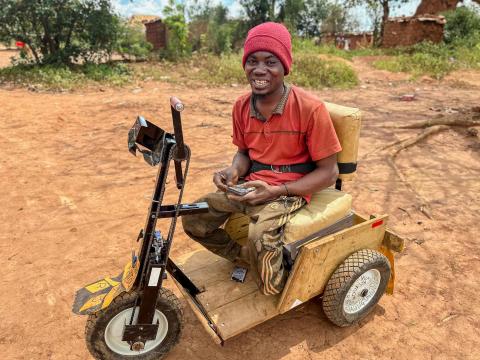DR Congo: Thanks to a wheelchair from World Vision, Aimé can now fully carry out his work

“Before, my feet could not walk. Today, it’s my willpower that runs,” says 32-year-old Aimé.
In Tshikala, in the mineral-rich Lualaba province, lives Aimé, a man known throughout his neighbourhood. Born without the use of his legs, he is recognised not for his disability but for his skill in repairing electronic devices. On his new wheelchair, a hand-painted inscription sums up his philosophy:
“God is chief of all, only He matters.”
Aimé embodies the resilience of millions of Congolese people living with mobility impairments. In the DRC, more than two million people are affected, often excluded from healthcare, education, and access to mobility. In Lualaba, despite its mineral wealth, the lack of adapted infrastructure exacerbates this exclusion, particularly.
A Skilled Handyman, but Limited by Immobility
Before receiving his wheelchair, Aimé spent his days in the family courtyard, under a mango tree, surrounded by makeshift tools: copper wires, old screwdrivers, and salvaged parts. Neighbours brought him silent radios, crackling telephones, and faulty chargers.
“Even with two bits of wire, I can fix a problem with power or volume,” he says.
Self-taught, he knows components as well as a musician knows their scales. His dream is to open a proper workshop with a suitable workbench, a soldering iron, and new spare parts, and perhaps train an apprentice. Yet his reduced mobility prevented him from reaching the market, suppliers, or certain clients; each trip required someone to carry him. His dependency, not his ability, was the greatest obstacle.
The Turning Point of the GIK Programme
In 2025, Aimé was one of two disabled residents of Tshikala to receive a wheelchair through World Vision DRC’s Gift-In-Kind (GIK) programme. This seemingly simple donation transformed his life. He was already earning a living repairing devices and phones, with daily earnings ranging from 500 Congolese francs (about USD 0.20) to 50,000 francs (about USD 20), but his work was confined to a few streets. Now, he can travel alone, seek orders, buy materials, visit clients, and make himself known.
“This wheelchair is my legs, but also my wings,” he says.
The wheelchair did not give him a trade, he already had one, but it gave him the freedom to practise it fully. His income still fluctuates, but he hopes to start saving soon:
“I’m not saving yet, but I fully intend to get there,” he affirms.
A Change in Image and Role
His newfound mobility eases the burden on his family, who no longer need to accompany him everywhere. In the neighbourhood, he is no longer “the young man in a wheelchair” but “the phone repairer”. Teenagers come to watch, seek advice, or admire his skills. His improvised workspace has become a meeting point for young people.
His wheelchair is now a symbol of usefulness, transmission of skills, and social recognition.
“People come to me now not out of pity, but because they need my hands,” he says.
The Impact of In-Kind Donations
Aimé’s story illustrates the power of well-targeted in-kind donations. World Vision’s GIK programme turns surplus goods, wheelchairs, school kits, medical equipment, and clothing into practical solutions for the most vulnerable. In 2023, the organisation distributed products worth over USD 250 million in 34 countries.
But the impact is not measured in figures alone; it is written in lives like Aimé’s. In a Lualaba where people with disabilities remain largely excluded, this wheelchair is a tool of social justice. It has enabled him to regain control of his daily life, serve his community, and be seen differently. If every donor could see the world through Aimé’s eyes, they would understand that a wheelchair does not simply move; it paves the way to human dignity.